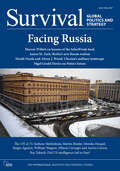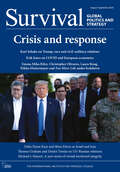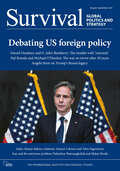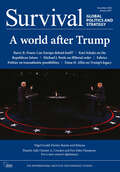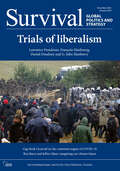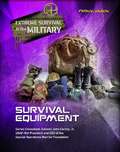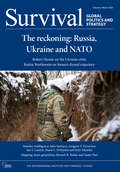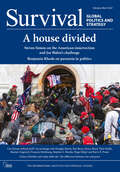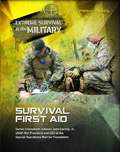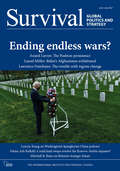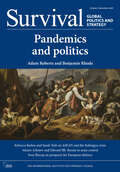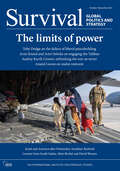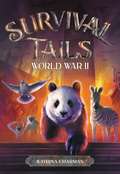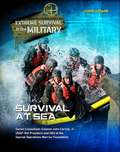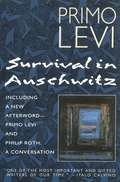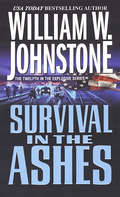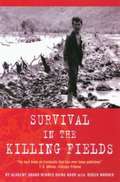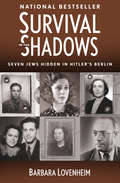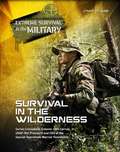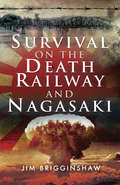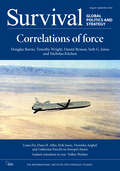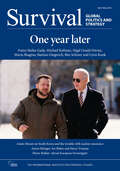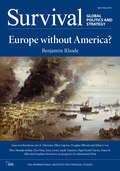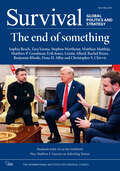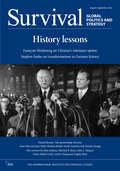- Table View
- List View
Survival April–May 2021: Facing Russia
by The International Institute for Strategic StudiesSurvival, the IISS’s bimonthly journal, challenges conventional wisdom and brings fresh, often controversial, perspectives on strategic issues of the moment.In this issue:Marcus Willett examines Russia’s SolarWinds hack and the painful lessons it holds for the United StatesIn a special forum, seven experts consider the purpose and effectiveness of the United Nations, as well as the intricacies of Security Council reform, on its 75th anniversaryPeter Rudolf argues that the United States’ perception of China as a revisionist strategic rival will complicate transatlantic policy coordinationRay Takeyh considers whether the US intelligence community bungled assessments of Iran’s political stability in the late 1970sAnd six more thought-provoking pieces, as well as our regular Book Reviews and Noteworthy column.Editor: Dr Dana AllinManaging Editor: Jonathan StevensonAssociate Editor: Carolyn WestAssistant Editor: Jessica Watson
Survival August-September 2020: Crisis and response
by The International Institute for Strategic StudiesSurvival, the IISS’s bimonthly journal, challenges conventional wisdom and brings fresh, often controversial, perspectives on strategic issues of the moment.In this issue:Dalia Dassa Kaye and Shira Efron argue that only a major shift in US policy towards Iran would rekindle debate in Israel about its approach to the Islamic RepublicJordan Calinoff and David Gordon contend that the accusation of ‘debt-trap diplomacy’ against China lacks convincing evidenceErik Jones examines the impact of COVID-19 on the EU economyMichael J. Mazarr calls for a new international norm to safeguard the virtual territorial integrity of states from subversive cyber attacksAnd ten more thought-provoking pieces, as well as our regular book reviews and Noteworthy column
Survival August-September 2021: Debating US Foreign Policy
by The International Institute for Strategic StudiesSurvival, the IISS’s bimonthly journal, challenges conventional wisdom and brings fresh, often controversial, perspectives on strategic issues of the moment.In this issue:Daniel Deudney and G. John Ikenberry argue that liberal internationalism is more appropriate to contemporary global realities than the Quincy-coalition restraintJames Crabtree explains why the West’s Build Back Better World partnership will be hard-pressed to compete with China’s Belt and Road InitiativeJoelien Pretorius and Tom Sauer contend that if states are serious about nuclear disarmament, they should ditch the NPT and join the Ban Treaty insteadSameer Lalwani and Tyler Sagerstrom analyse what the India–Russia defence partnership means for US policyAnd eight more thought-provoking pieces, as well as our regular Book Reviews and Noteworthy column.Editor: Dr Dana AllinManaging Editor: Jonathan StevensonAssociate Editor: Carolyn WestAssistant Editor: Jessica Watson
Survival December 2020–January 2021: A World After Trump
by The International Institute for Strategic StudiesSurvival, the IISS’s bimonthly journal, challenges conventional wisdom and brings fresh, often controversial, perspectives on strategic issues of the moment.In this issue:Barry Posen argues that Europe is better placed to defend itself militarily than many, including the IISS, have portrayed it to beKori Schake examines the prospects of Republican politics in a post-Trump AmericaDaniel Byman and Aditi Joshi call for protocols to curb the abuse of social media by malign agents and statesNigel Gould-Davies explains Russia’s stance on Belarus with reference to Moscow’s long history of involving itself in its neighbours’ affairsAnd nine more thought-provoking pieces, as well as our regular book reviews and Noteworthy column.Editor: Dr Dana AllinManaging Editor: Jonathan StevensonAssociate Editor: Carolyn WestAssistant Editor: Jessica Watson
Survival December 2021-January 2022: Trials of Liberalism
by The International Institute for Strategic StudiesSurvival, the IISS’s bimonthly journal, challenges conventional wisdom and brings fresh, often controversial, perspectives on strategic issues of the moment.In this issue:Gigi Kwik Gronvall examines the contested origin of SARS-CoV-2 and argues that scientific work should be apolitical and globally cooperated, including with ChinaLawrence Freedman contends that while liberalism is in crisis, it should still be better than authoritarianism at adapting to new circumstances, acknowledging salient problems and choosing among alternativesRobert S. Ross argues that Chinese strategists believe Beijing can challenge a strategically weakened United States on the Korean PeninsulaOndrej Rosendorf, Michal Smetana and Marek Vranka assess that persuading the public that nuclear abolition is feasible could strengthen disarmament advocacyAnd nine more thought-provoking pieces, as well as our regular Book Reviews and Noteworthy column.Editor: Dr Dana AllinManaging Editor: Jonathan StevensonAssociate Editor: Carolyn WestAssistant Editor: Jessica Watson
Survival Equipment
by Patrick WilsonBeing in the Special Forces means you will be taken all over the world for some of the most difficult missions, often to unfriendly places and dangerous regions. Elite soldiers must be trained to survive anywhere, whether in the endless deserts of Africa or the freezing tundra of the Arctic. Soldiers need to know how to survive for weeks or even months at a time. They must also know how to survive with as few supplies as possible; after all, in the wilderness, you can't drop by the store to resupply! Find out what equipment elite soldiers need to have with them to survive. Discover how to improvise equipment using only the natural resources around you. Learn: * what clothing to wear in hot and cold climates. * what equipment to carry. * what a survival tin is and what's inside it. * how to make your own tools and clothing. * how to survive hostile terrains.
Survival February - March 2022: The Reckoning: Russia, Ukraine and NATO
by The International Institute for Strategic StudiesSurvival, the IISS’s bimonthly journal, challenges conventional wisdom and brings fresh, often controversial, perspectives on strategic issues of the moment.In this issue:· The Ukraine crisis: Robert Hunter argues that the most important requirement of successful US-led negotiations with Russia is that Moscow demonstrate that it is prepared to be a responsible international actor· Erin Sikorsky contends that climate change should have a larger role in the day-to-day national-security agendas of the United States and other countries· Stephan Frühling and Andrew O’Neil warn that current US debates about no first use tend to underplay the broader alliance implications of any shift in US nuclear policy· Rahul Roy-Chaudhury and Kate Sullivan de Estrada assess that, given the 2021 US FONOP targeting India, Washington and New Delhi need to better manage their diverse positions on global governance, especially in the maritime domain· Nien-chung Chang-Liao warns that pragmatism in Chinese foreign policy is waning and considers why Chinese diplomats have become so aggressiveAnd nine more thought-provoking pieces, as well as our regular Book Reviews and Noteworthy column.Editor: Dr Dana AllinManaging Editor: Jonathan StevensonAssociate Editor: Carolyn WestAssistant Editor: Jessica Watson
Survival February–March 2021: A House Divided
by The International Institute for Strategic StudiesSurvival, the IISS’s bimonthly journal, challenges conventional wisdom and brings fresh, often controversial, perspectives on strategic issues of the moment.In this issue:Steven Simon argues that despite the violent storming of the US Capitol, Republicans are inclined to commit to minority ruleIn a special forum, IISS researchers and three other experts consider whether NATO’s European members can defend themselves without US supportHanns W. Maull contends that the coronavirus pandemic has revealed deficiencies of global governance, and analyses their implications for the future of international orderChristopher W. Hughes, Alessio Patalano and Robert Ward examine Japan’s grand strategy and Abe Shinzo’s legacy And seven more thought-provoking pieces, as well as our regular Book Reviews and Noteworthy column.Editor: Dr Dana AllinManaging Editor: Jonathan StevensonAssociate Editor: Carolyn WestAssistant Editor: Jessica Watson
Survival First Aid
by Patrick WilsonElite soldiers often operate in hard-to-reach locations or far behind enemy lines. If one of them is injured, medical attention is rarely readily available. For this reason, soldiers must be trained to treat injuries themselves. This book will show you how to treat some of the most common injuries and illnesses that you're likely to get in the wilderness. Whether it's a small problem like a blister or a major health concern like a heart attack, it's important to know how to deal with any injury or medical problem. Learn how to: * treat someone who has eaten a poisonous plant. * set broken legs after a climbing fall. * deal with hypothermia, when the body's temperature drops dangerously low. * provide treatment for severe burns. * stop a person from bleeding to death.
Survival June-July 2021: Ending Endless Wars?
by The International Institute for Strategic StudiesSurvival, the IISS’s bimonthly journal, challenges conventional wisdom and brings fresh, often controversial, perspectives on strategic issues of the moment.In this issue:Anatol Lieven argues that the Taliban will remain the most powerful military and political force among the Pashtuns of AfghanistanLanxin Xiang contends that, following what he describes as Donald Trump’s racist China policy, the Biden administration must avoid casting China as an alien threatDani Filc and Sharon Pardo assess that right-wing populists in Israel and Europe have become ideological allies, harnessing ethnic nationalism against global IslamAlex J. Bellamy and Charles T. Hunt analyse the intricacies of the use of force to protect civilians in UN peacekeeping missions And seven more thought-provoking pieces, as well as our regular Book Reviews and Noteworthy column.Editor: Dr Dana AllinManaging Editor: Jonathan StevensonAssociate Editor: Carolyn WestAssistant Editor: Jessica Watson
Survival October-November 2020: Pandemics and politics
by Adam Roberts Benjamin RhodeSurvival, the IISS’s bimonthly journal, challenges conventional wisdom and brings fresh, often controversial, perspectives on strategic issues of the moment.In this issue:Adam Roberts explores pandemics and politics through the ages, arguing that trust in leadership is essential in the struggle against infectious diseasesRebecca Barber and Sarah Teitt contend that ASEAN should take a more activist approach to the Rohingya crisis to salvage its credibilityGreg Austin assesses the strategic implications of China’s weak cyber defencesØystein Tunsjø casts doubt on the prospect of the Arctic becoming a theatre of great-power conflictAnd eight more thought-provoking pieces, as well as our regular book reviews and Noteworthy column.
Survival October-November 2021: The Limits of Power
by The International Institute for Strategic StudiesSurvival, the IISS’s bimonthly journal, challenges conventional wisdom and brings fresh, often controversial, perspectives on strategic issues of the moment.In this issue:· Anatol Lieven argues that realist support for prudence and restraint in foreign policy does not equate to chauvinism, isolationism and opposition to international cooperation· Toby Dodge assesses that the United States’ attempt to comprehensively transform Afghanistan was based on its erroneous presumption that the liberal-peacebuilding model was universally applicable· Audrey Kurth Cronin contends that the logic of fighting terrorists far from the US homeland no longer holds, as the US faces resource constraints and rising domestic terrorism· Jens Ringsmose and Sten Rynning analyse the potential priorities and scope of NATO’s next Strategic Concept, and how it can bridge the Alliance’s political–military divideAnd eight more thought-provoking pieces, as well as our regular Book Reviews and Noteworthy column.Editor: Dr Dana AllinManaging Editor: Jonathan StevensonAssociate Editor: Carolyn WestAssistant Editor: Jessica Watson
Survival Tails: World War II (Survival Tails #3)
by Katrina CharmanA brave messenger pigeon enlists a group of heroic zoo animals to help him complete his mission in this thrilling, informative read, perfect for fans of the Ranger in Time and I Survived seriesWorld War II is raging across Europe and the German army has their sights set on England. Messenger pigeon Francis carries important notes back and forth between England and her allies, and wants nothing more than to do his part for the war effort. But when Francis is injured on an assignment to deliver the most important message of the war--one which warns of a coming attack on Britain itself--he finds himself stranded in the middle of the London Zoo with no way to complete his mission.Ming, the world-famous panda, has so far managed to avoid being caught up in the war. But that's getting harder and harder to do as the zoo suffers under dwindling food rations and German air raids threaten the city every night. When Francis lands in Ming's enclosure, she knows she can no longer stand by and do nothing. Enlisting the help of a kind zookeeper and a resourceful troop of monkeys, Ming fights to help Francis recover his strength so that he can carry out his mission.But when the war finally arrives in London, threatening everyone in the zoo, Francis, Ming, and the other animals must work together to save themselves...and maybe even London itself.
Survival at Sea
by Chris McnabElite soldiers must know how to survive in every environment, including if they're stranded on the harshest ocean. Special Forces units trained to survive at sea are some of the most knowledgeable people in the world when it comes to a survival situation in the ocean. In this book, you will learn some of the techniques these soldiers use to stay alive at sea. You can learn from their training and discover: * what to do when a shark attacks. * how to tell when a storm is coming. * how to swim so that you save energy. * how to signal for help in the middle of the ocean. * how to treat a jellyfish sting. * how to build a raft out of logs or saplings.
Survival in Auschwitz
by Primo LeviLevi's classic account of his ten months in the german death camp.
Survival in the Ashes (Ashes #12)
by William W. JohnstoneBloodthirsty mercenaries and fanatical assassins stand between a post-apocalyptic army and freedom—from a USA Today–bestselling author. Ben Raines and his freedom-fighting guerrillas are camped along the banks of what was once the Mississippi River, plotting strategy and readying weapons. A massive pack of heavily armed troops looms on the horizon, marching straight for the Rebels. They are the insidious mercenaries of Kenny Par and Lan Viller, and by midday only the Mississippi separates Raines from the ten thousand blood-hungry warriors all sworn to turn the Rebels' dream into a hellish nightmare. Just as Ben formulates a brilliant battle plan, a Rebel scout reports that the fanatical assassins of Sister Volenta's Ninth Order are approaching from Ben's back. The Rebels will soon be surrounded by freedom's deadliest foes, and a defeat for Raines would mean the end of the Rebel dream. But victory, if he can pull it off, could be the beginning of a new America. Twelfth in the long-running series!
Survival in the Killing Fields
by Haing Ngor Roger WarnerNothing has shaped my life as much as surviving the Pol Pot regime. I am a survivor of the Cambodian holocaust. That's who I am," says Haing Ngor. And in his memoir, Survival in the Killing Fields, he tells the gripping and frequently terrifying story of his term in the hell created by the communist Khmer Rouge. Like Dith Pran, the Cambodian doctor and interpreter whom Ngor played in an Oscar-winning performance in The Killing Fields, Ngor lived through the atrocities that the 1984 film portrayed. Like Pran, too, Ngor was a doctor by profession, and he experienced firsthand his country's wretched descent, under the Khmer Rouge, into senseless brutality, slavery, squalor, starvation, and disease-all of which are recounted in sometimes unimaginable horror in Ngor's poignant memoir. Since the original publication of this searing personal chronicle, Haing Ngor's life has ended with his murder, which has never been satisfactorily solved. In an epilogue written especially for this new edition, Ngor's coauthor, Roger Warner, offers a glimpse into this complex, enigmatic man's last years-years that he lived "like his country: scarred, and incapable of fully healing. "
Survival in the Shadows: Seven Jews Hidden in Hitler's Berlin
by Barbara LovenheimThe remarkable true story of two families that survived against all odds in the heart of the Nazi capitalSurvival in the Shadows rivetingly chronicles the incredible survival of seven German Jews in Berlin through the final and most deadly years of the Holocaust. In January 1943, unable to flee Germany, the four members of the Arndt family went underground to avoid deportation to Auschwitz. Soon they were joined by Ellen Lewinsky and her mother, Charlotte; a year later, Bruno Gumpel joined the group. Hiding in a small factory fewer than two miles from Hitler's bunker, without identification cards or food-ration stamps, they were dependent on German strangers for sustenance and anonymity. When Russian soldiers finally rescued the group in April 1945, the families were perilously near death from starvation. But their will to live triumphed. Most joyously, two months later, four of the survivors--Erich Arndt and Ellen Lewinsky, and Ruth Arndt and Bruno Gumpel--reunited in a double wedding ceremony. In her compelling and captivating book, Barbara Lovenheim shares this previously untold story, relayed to her by three surviving members of the group, whom she met by chance in her hometown. Survival in the Shadows is a touching portrayal of the resourcefulness and bravery of the seven Jews in hiding as well as the fortitude and humanity of the ordinary Germans who kept them alive.
Survival in the Wilderness
by Chris McnabMost people find themselves out in the wilderness at some point in their lives, even if they're just heading out for a camping trip. If the worst happens and you're stranded away from civilization, it's important to know how to survive. The elite forces of the world are trained to survive in the most hostile of environments. They can teach you some of the techniques they use and equipment that you'll need. Some of the tips they offer include: * Use swarming insects to tell you where water can be found. * Determine whether a plant is poisonous by the color of its berries. * Move wet stones away from a fire (they can explode). * Don't build a shelter too close to a river (it could flood). * Make signals by cutting out shapes in vegetation.
Survival on the Death Railway and Nagasaki: A Pow Story Of Survival On The Death Railway And Nagasaki [large Print 16pt]
by Jim BrigginshawThis is a remarkable and unique story of Jim Brigginshaw. Having been captured by the Japanese after the fall of Singapore in 1942, Jim was first sent to work in Burma, to build what has become known as the Death Railway. Unlike many of his comrades, Jim survived this ordeal, only to be transferred to Nagasaki, Japan, where he was sent to work in the mines of Sendryu.Jim describes how the conditions in the 'Hell pits of Sendryu' were even worse than those experienced in Burma, but were ultimately the reason why he survived the war. On the 9th August 1945, the Americans, dropped the second nuclear bomb on Nagaski. Jim was fortunately underground at the time, but through this book re-lives the harrowing aftermath of the attack when the ground shook violently.
Survival: 66.4
Survival, the IISS’s bimonthly journal, challenges conventional wisdom and brings fresh, often controversial, perspectives on strategic issues of the moment.In this issue:· Douglas Barrie and Timothy Wright underscore the need for Washington to prioritise qualitative rather than quantitative improvements to its nuclear capabilities – free to read · Catherine Fieschi examines the implications of an indecisive French election· Daniel Byman and Seth G. Jones explore the increasing ties between China, Russia, Iran and North Korea and obstacles to deeper cooperation · Veronica Anghel and Erik Jones examine how the European Union can utilise its most powerful instrument – enlargement – to stabilise its peripheries · And eight more thought-provoking pieces, as well as our regular Book Reviews and Noteworthy column.Editor: Dr Dana AllinManaging Editor: Jonathan StevensonAssociate Editor: Carolyn WestEditorial Assistant: Conor Hodges
Survival: April - May 2023
by The International Institute for Strategic StudiesSurvival, the IISS’s bimonthly journal, challenges conventional wisdom and brings fresh, often controversial, perspectives on strategic issues of the moment. In this issue: Franz-Stefan Gady and Michael Kofman assess that Ukraine will not be able to avoid attrition in its military strategy against Russia Nigel Gould-Davies assesses that Vladimir Putin’s priority has shifted from demobilising the population from politics to mobilising it behind the war Bastian Giegerich and Ben Schreer judge that Germany still requires significant changes to its defence and foreign policies for Zeitenwende to be meaningful Lynn Kuok believes that framing great-power competition as an ideological struggle is counterproductive to the United States’ partnerships in the Asia-Pacific Adam Mount observes that a fixation on nuclear assurance is harming the military alliance between the United States and South Korea And seven more thought-provoking pieces, as well as our regular Book Reviews and Noteworthy column. Editor: Dr Dana Allin Managing Editor: Jonathan Stevenson Associate Editor: Carolyn West Editorial Assistant: Charlie Zawadzki
Survival: April – May 2024
Survival, the IISS’s bimonthly journal, challenges conventional wisdom and brings fresh, often controversial, perspectives on strategic issues of the moment.In this issue:• Benjamin Rhode examines the threat of Europe’s security guarantor of the past 80 years stepping back• Ellen Laipson and Douglas Ollivant explore how the Gaza war has threatened Iraq’s balancing act between the US and Iran• Nigel Gould-Davies cautions that, despite the West’s economic superiority over Russia, it is starting to look like the balance of resolve in the Ukraine war favours Russia• Dana H. Allin and Jonathan Stevenson examine the mystery of why new aid for Ukraine is blocked in the US Congress in spite of bipartisan support• And eight more thought-provoking pieces, as well as our regular Book Reviews and Noteworthy column.Editor: Dr Dana AllinManaging Editor: Jonathan StevensonAssociate Editor: Carolyn WestEditorial Assistant: Conor Hodges
Survival: April-May 2025
Survival, the IISS’s bimonthly journal, challenges conventional wisdom and brings fresh, often controversial, perspectives on strategic issues of the moment.In this issue: Sophia Besch and Tara Varma analyse the influence of the ‘Make America Great Again’ movement on the revisionist agenda in Europe Shashank Joshi evaluates the challenge of maintaining meaningful human control in decision-making as the role of artificial intelligence on the battlefield advances Matthew F. Cancian explores how the principle of ‘denial over weeks’ could save the United States from a prolonged and unwinnable war over Taiwan Dana H. Allin and Christopher S. Chivvis assess the impact of the early moves of Donald Trump’s second administration on the relationship between Europe and the United States And nine other thought-provoking pieces, as well as our regular Book Reviews and Noteworthy column To read free articles from the journal, please visit its homepage at https://www.tandfonline.com/journals/tsur20.Editor: Dr Dana AllinManaging Editor: Jonathan StevensonAssociate Editor: Carolyn WestEditorial Assistant: Anna Gallagher
Survival: August 2023
by The International Institute for Strategic StudiesSurvival, the IISS’s bimonthly journal, challenges conventional wisdom and brings fresh, often controversial, perspectives on strategic issues of the moment. In this issue: François Heisbourg assesses that Ukraine might have to accept the de facto division of the country to secure a fast track into NATO Daniel Byman writes that state ties to terrorist groups are likely to feature in the western alliance’s long-term confrontation with Russia and in its rivalry with China Juan Pablo Medina Bickel and Irene Mia assess that global climate mitigation and the energy transition could reinforce South America’s geopolitical clout From the Survival archives, the late David P. Calleo predicted in 1999 that a successful euro would enhance the EU’s diplomatic and military capabilities, while the late James Dobbins considered in 2012 how the US could prevent a war with China Dana H. Allin and John L. Harper reflect on long-time Survival contributing editor David P. Calleo’s legacy And nine more thought-provoking pieces, as well as our regular Book Reviews and Noteworthy column. Editor: Dr Dana Allin Managing Editor: Jonathan Stevenson Associate Editor: Carolyn West
